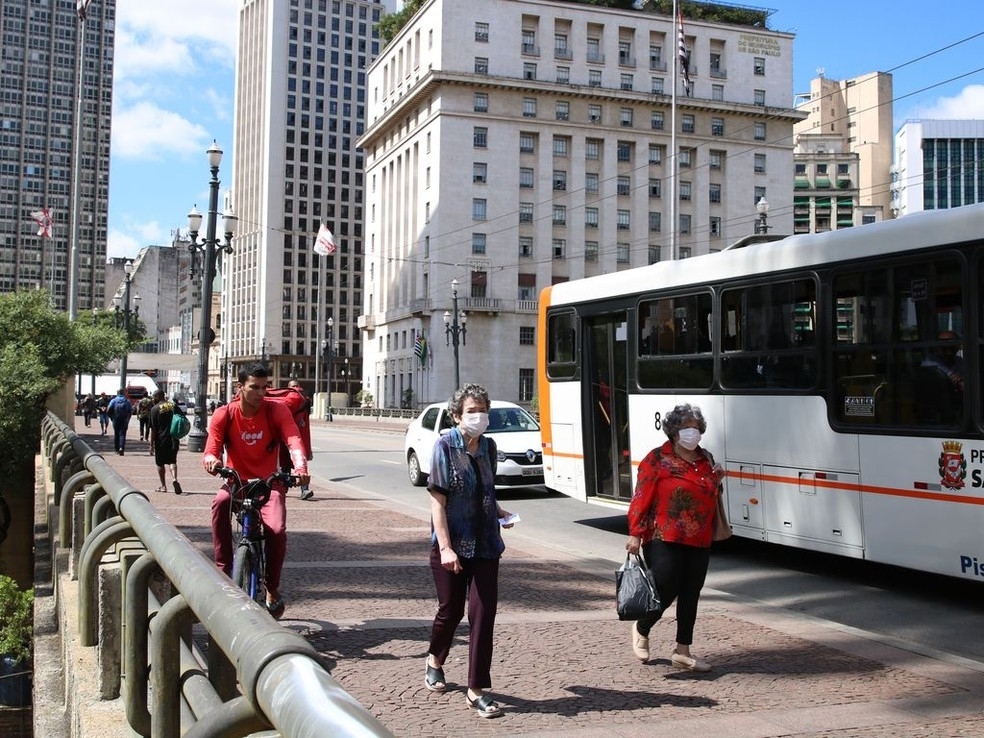


A multinational research group used data from São Paulo to perform calculations which suggest that even a minor reduction in the city’s mobility – equivalent to a rise from 45% to 50% in the social distancing index – correlates with a considerable fall in new infections and deaths after a few days (photo: Rovena Rosa/Agência Brasil)
Published on 04/26/2021
By Maria Fernanda Ziegler | Agência FAPESP – A study by researchers at the University of São Paulo in Brazil, Leeds University in the United Kingdom and Harvard University in the United States suggests that air pollution and mobility can be used as indicators to predict trends in COVID-19 cases and deaths.
An unrefereed article published on the preprint platform medRxiv concludes that even minor decreases in air pollution and mobility in the city of São Paulo correlate with a significant drop in new infections and deaths from the disease within a relatively short period.
“It’s important to bear in mind that the study is purely mathematical,” said Edmilson Dias de Freitas, a professor at the University of São Paulo’s Institute of Astronomy, Geophysics and Atmospheric Sciences (IAG-USP) and a co-author of the article on the study, which was supported by FAPESP via three projects (15/03804-9, 16/18438-0 and 16/10557-0).
By correlating social distancing, epidemiological, pollution, and climate data, the authors calculated that a mobility index of 45.28% in São Paulo city was associated with 1,212 new cases and 44 new deaths from the disease. When isolation increased to 50%, however, the number of new cases fell to 438 and almost half of the deaths were avoided.
The analysis was conducted by researchers in atmospheric sciences as part of research projects supported by FAPESP. The mobility index was tracked during the pandemic via the São Paulo state government’s Smart Monitoring System (SIMI-SP), which uses non-personalized location data supplied by mobile telephone operators. The authors also used data from Google’s COVID-19 Community Mobility Reports.
The isolation number (45.28%) was the median for São Paulo city according to SIMI-SP and correlated most closely with the epidemiological data. On March 16, 2021, when mobility restrictions were taken to the highest level and a record number of deaths from COVID-19 were reported, the index was 42%.
“Besides statistical associations between COVID-19 and isolation numbers, we also observed clear-cut temporal patterns. Cases increased between four and nine days after mobility increased, while deaths increased after 18 days,” said Sergio Ibarra-Espinosa, a researcher at IAG-USP and first author of the article.
Although the study did not take specific epidemiological factors into account, the findings accord with what is known about the progression of COVID-19, such as the incubation period of four to nine days before symptoms appear.
“Very clear patterns are observed, making this indicator important to policymakers. It shows that more social distancing and isolation can avoid deaths, and it also shows conversely that the more mobility in the city, the more COVID-19 cases and deaths. We saw this last Christmas and New Year, and as a result of other holidays since then,” said Amanda Rehbein, a co-author of the article and a researcher at IAG-USP with a doctoral scholarship from FAPESP.
Transmission peak and overwhelmed health services
The researchers used data collected between March 27, 2020, and March 12, 2021, before the peak of the pandemic in the city, so the study does not consider trends such as the overwhelming of health services and the effects of mask wearing, hand hygiene or income compensations to support confinement.
“The impact may be significantly worse when health services are overwhelmed and proper treatment isn’t available for everyone,” Freitas said. “For example, the correlations observed during the study period didn’t include lack of emergency care, which is a crucial driver of the number of deaths.”
The researchers also found that an increase in levels of particle pollution and ozone in the atmosphere correlated with the rise in numbers of COVID-19 cases and deaths. “We don’t know the reason for this yet. It’s a respiratory disease, so air pollution may make it worse. Another possibility is that pollution levels are indicators of mobility since particulate matter and ozone are associated with fossil fuel burning,” Freitas said.
The article “Association between COVID-19, mobility and environment in São Paulo, Brazil” can be read at: www.medrxiv.org/content/10.1101/2021.02.08.21250113v1.
Source: https://agencia.fapesp.br/35715